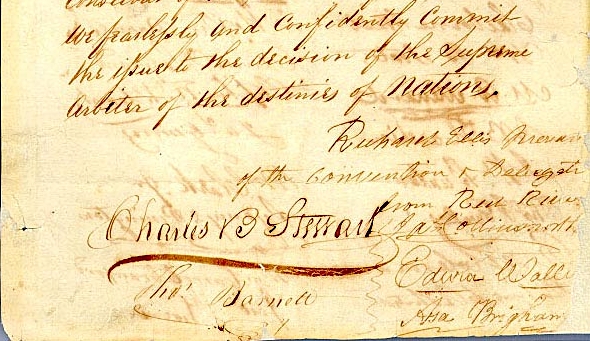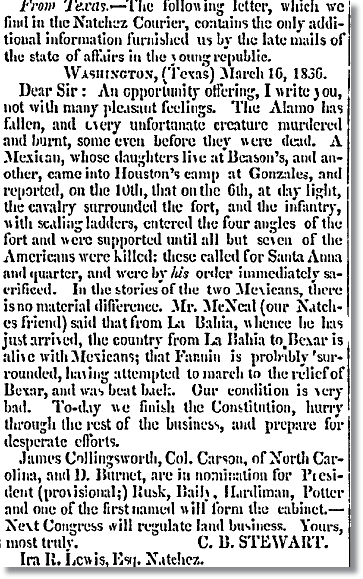
CHARLES B. STEWART SIGNER OF THE TEXAS DECLARATION OF INDEPENDENCE
Charles B. Stewart's John Hancock-like Signature on the Texas Declaration of Independence
Texas State Library and Archives ...we fearlessly and confidently commit Richard Ellis, President of the Convention & Delegate from Red River
Charles B. Stewart Thos Barnett
James Collinsworth Edwin Waller Asa Brigham
1836 Marriage of C. B. Stewart On March 1, 1836, at Washington (Washington-on-the Brazos), the Texian Independence Convention began. The convention lasted from March 1 to March 17, 1836. The delegates to the convention declared Texas independent from Mexico on March 2, 1836. One of these delegates was Charles B. Stewart. Stewart, who had already served as the first Secretary of State of Texas, was an active member of the convention where he signed the Texas Declaration of Independence and was a member of the committee that drafted the Constitution of the Republic of Texas. Later, historians would credit him with designing the Lone Star flag and Seal of Texas in the Town of Montgomery, Texas in 1839. On March 6, 1836, the Alamo fell. As the Texas Revolution raged on, an interesting and little known fact about C. B. Stewart occurred. C. B. Stewart, one of the most active members of the convention at Washington left the convention for several days and got married. On March 8, 1836, James Hall, Judge of the Municipality of Washington, authorized "W. W. Shepperd of Lake Creek" to celebrate a contract of marriage between C. B. Stewart and Julia Shepperd.8 Stewart left Washington and traveled to the house of W. W. Shepperd on Lake Creek where he married Julia Shepperd (W. W. Shepperd's daughter) on March 11, 1836.9 Washington County Clerk, Deed Book A-1, p. 240
Washington County Clerk, Deed Book A-1, p. 243
So C. B. Stewart and Julia T. Shepperd were married on March 11, 1836, in the Lake Creek Settlement on the lands that would later become the original Town of Montgomery in July of 1837. Witnesses to the marriage were John Marshall Wade, Charles Garrett and William C. Clark. Stewart then returned to the convention at Washington by March 16 where he signed the Constitution of the Republic of Texas on March 17, 1836. Below is a letter written by C. B. Stewart on the day he returned to the Convention at Washington (March 16, 1836) describing the fall of the Alamo and the desperate situation in Texas. March 16, 1836 C. B. Stewart Letter to Ira R. Lewis
Washington, (Texas) March 16, 1836
Dear Sir: An opportunity offering, I write you, not with many pleasant feelings. The Alamo has fallen, and every unfortunate creature murdered and burnt, some even before they were dead. A Mexican, whose daughters live at Beason’s, and another, came into Houston’s camp at Gonzales, and reported, on the 10th, that on the 6th, at day light, the cavalry surrounded the fort, and the infantry, with scaling ladders, entered the four angles of the fort and were supported until all but seven of the Americans were killed: these called for Santa Anna and quarter, and were by his order immediately sacrificed. In the stories of the two Mexicans, there is no material difference. Mr. McNeal (our Natchez friend) said that from La Bahia to Bexar is alive with Mexicans; that Fannin is probably surrendered, having attempted to march to the relief of Bexar, and was beat back. Our condition is very bad. To-day we finish the Constitution, hurry through the rest of the business, and prepare for desperate efforts. James Collingsworth, Col. Carson, of North Carolina, and D. Burnet, are in nomination for President (provisional;) Rusk, Baily, Hardimann, Potter and one of the first named will form the cabinet. – Next Congress will regulate land business. Yours, most truly.
For primary source, see Public Ledger, Philadelphia, Penn., Tuesday, April 19, 1836, Vol. 1, No. 22, p. 2. This letter, written by C. B. Stewart after his return to the Convention at Washington on March 16, 1836, is interesting for a number of reasons. It reports the fall of the Alamo and the probable surrender of Fannin. It also advises that the Constitution of the Republic of Texas is going to be finished on March 16, 1836. The names of the men put into nomination for Ad Interim President of the Republic of Texas are also provided here.
CHARLES B. STEWART SIGNER OF THE DECLARATION OF INDEPENDENCE
By Sam Houston Dixon
Came to Texas in 1830—Member of the Consultation 1835--Executive Secretary To Governor Smith--Delegate to the Convention Which Met at Old Washington, March 1, 1836--Member Annexation Convention 1845--Member First Legislature—Death in Montgomery County.
Charles B. Stewart was a man of splendid intellectual attainments and distinguished himself in the early days of the Republic as a prudent and courageous defender of the principles of liberty, for which the colonists were battling. During his fifty years residence in Texas he witnessed many scenes, which are records of historical interest and value. He began his public career as an officer of the General Consultation at San Felipe in 1835. During the convention he demonstrated his fitness for place of responsibility, and when a provisional government was formed and Henry Smith elected provisional governor, he appointed Mr. Stewart Executive Secretary, an office at that critical period of the State’s history, second only in importance to that of the governor. In this position he rendered signal service to the government. He was methodical, courteous and affable, and the records of his office were kept in complete order. When the Chief Executive or the General Council desired to examine any particular file of his office he was always ready to put his hands on it without a moment’s delay. Governor Smith found Mr. Stewart a safe and wise counselor, and testified to his splendid character in this language:
Mr. Stewart was born in South Carolina, August 8, 1806. He came to Texas from Louisiana in 1830, and soon became a prominent and conspicuous leader among the colonists. He was a member of the Consultation of 1835. After the adjournment of the Consultation and the provisional government had been established, he was appointed Executive Secretary to Governor Henry Smith. He remained a strong supporter of Governor Smith when the General Council attempted to remove him (Smith) from from office. On Mr. Stewart’s refusal to turn over the archives of his office to Lieutenant Governor J.W. Robinson, whom the Council had recognized as governor, he was fined $2,500 by the General Council. No effort, however, was ever made to collect the fine. When the convention was called to meet at Old Washington, March 1, 1836, Mr. Stewart was elected a delegate to this convention, and thus became a signer of the Declaration of Independence adopted by that convention. He took a most prominent part in the convention proceedings and served on the committee to draft a constitution for the new government [Republic of Texas]. Mr. Stewart located permanently in Montgomery County. He represented that county in the Convention of 1845, which formed the Constitution under which Texas was annexed to the United States. He also represented Montgomery County in the First Texas legislature in 1846. He represented Montgomery County in the Legislature in 1851-52, 1876-77 and again in 1883-84. Mr. Stewart retained to the very last a vivid recollection of the early struggles of the Texas pioneers. The writer had many conversations with him at his home in Montgomery County and while he was a member of the Texas legislature, and secured from him valuable historical information pertaining to the early history of Texas and the pioneers who took part in establishing civil and religious liberty in the Republic. His account of Chief Field’s, of the Cherokees, attempt to establish a branch of that tribe on Clear Lake, Montgomery County, is the most authentic record of that event of which students of Texas history have any knowledge. Mr. Stewart left a family of sons and daughters who became prominent and useful citizens of the State. Governor E. M. Pease, who became acquainted with Mr. Stewart in 1835 and who met him frequently in after years, said this of him:
The source of this text is from The Men Who Made Texas Free, Sam Houston Dixon, 1924, Texas Historical Publishing Company, Houston, pp. 239-241. Note: Content in Sam Houston Dixon's article/chapter on Charles B. Stewart has not been verified by the Texas History Page and should only be used a starting point for researchers. |

